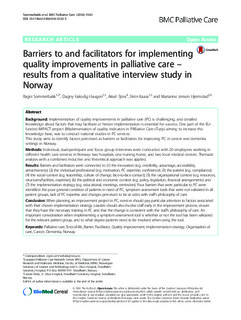| dc.contributor.author | Sommerbakk, Ragni | |
| dc.contributor.author | Haugen, Dagny Faksvåg | |
| dc.contributor.author | Tjora, Aksel | |
| dc.contributor.author | Kaasa, Stein | |
| dc.contributor.author | Hjermstad, Marianne Jensen | |
| dc.date.accessioned | 2016-09-02T12:16:25Z | |
| dc.date.accessioned | 2016-09-05T11:46:53Z | |
| dc.date.available | 2016-09-02T12:16:25Z | |
| dc.date.available | 2016-09-05T11:46:53Z | |
| dc.date.issued | 2016 | |
| dc.identifier.citation | BMC Palliative Care 2016, 15:61 | nb_NO |
| dc.identifier.issn | 1472-684X | |
| dc.identifier.uri | http://hdl.handle.net/11250/2404307 | |
| dc.description.abstract | Background:
Implementation of quality improvements in palliative care (PC) is challenging, and detailed knowledge about factors that may facilitate or hinder implementation is essential for success. One part of the EU-funded IMPACT project (IMplementation of quality indicators in PAlliative Care sTudy) aiming to increase the knowledge base, was to conduct national studies in PC services.
This study aims to identify factors perceived as barriers or facilitators for improving PC in cancer and dementia settings in Norway.
Methods:
Individual, dual-participant and focus group interviews were conducted with 20 employees working in different health care services in Norway: two hospitals, one nursing home, and two local medical centers. Thematic analysis with a combined inductive and theoretical approach was applied.
Results:
Barriers and facilitators were connected to (1) the innovation (e.g. credibility, advantage, accessibility, attractiveness); (2) the individual professional (e.g. motivation, PC expertise, confidence); (3) the patient (e.g. compliance); (4) the social context (e.g. leadership, culture of change, face-to-face contact); (5) the organizational context (e.g. resources, structures/facilities, expertise); (6) the political and economic context (e.g. policy, legislation, financial arrangements) and (7) the implementation strategy (e.g. educational, meetings, reminders). Four barriers that were particular to PC were identified: the poor general condition of patients in need of PC, symptom assessment tools that were not validated in all patient groups, lack of PC expertise and changes perceived to be at odds with staff’s philosophy of care.
Conclusion:
When planning an improvement project in PC, services should pay particular attention to factors associated with their chosen implementation strategy. Leaders should also involve staff early in the improvement process, ensure that they have the necessary training in PC and that the change is consistent with the staff’s philosophy of care. An important consideration when implementing a symptom assessment tool is whether or not the tool has been validated for the relevant patient group, and to what degree patients need to be involved when using the tool. | nb_NO |
| dc.language.iso | eng | nb_NO |
| dc.publisher | BioMed Central | nb_NO |
| dc.rights | Navngivelse 3.0 Norge | * |
| dc.rights.uri | http://creativecommons.org/licenses/by/3.0/no/ | * |
| dc.title | Barriers to and facilitators for implementing quality improvements in palliative care – results from a qualitative interview study in Norway | nb_NO |
| dc.type | Journal article | nb_NO |
| dc.type | Peer reviewed | nb_NO |
| dc.date.updated | 2016-09-02T12:16:25Z | |
| dc.source.journal | BMC Palliative Care | nb_NO |
| dc.identifier.doi | 10.1186/s12904-016-0132-5 | |
| dc.identifier.cristin | 1371270 | |
| dc.description.localcode | © 2016 The Author(s). This article is distributed under the terms of the Creative Commons Attribution 4.0 International License (http://creativecommons.org/licenses/by/4.0/), which permits unrestricted use, distribution, and reproduction in any medium, provided you give appropriate credit to the original author(s) and the source, provide a link to the Creative Commons license, and indicate if changes were made. The Creative Commons Public Domain Dedication waiver (http://creativecommons.org/publicdomain/zero/1.0/) applies to the data made available in this article, unless otherwise stated. | nb_NO |

